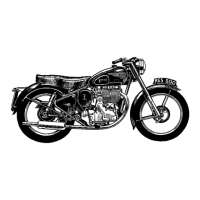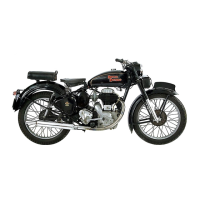5.
Removal
of
Contact
breaker
housing.
Loosen the distributor pinion nut and pull out the distributor pinion off the distributor
shaft after removing the idler pinions.
Loosen and remove the three screws which
secure the spigotted contact breaker housing
and seperate from crankcase. Remove the contact breaker cover. Remove the base plate after
removing the two hex bolts securing
it.
Pull
out the contact breaker shaft from the housing. The two sintered bushes provided in
S-
the housing would have to be replaced only
if
excessive radial play
is
noticed on the distributor
shaft.
Reassembly is just the reverse process of dismantling but take care to replace the washer
between the contact breaker housing and the crank case.
DE7AlL OF FELT OIL
CLEANER
6.
Valve
Timing
The cams are integral with the cam pinions. They
have internal sintered iron bushes running on fixed
spindles in the timing chest.
The cams and the timing pinion are provided with
timing marks to set proper valve timing. The
procedure is detailed below.
\
Bring the piston to TDC Match the
exhaust
cam
(provided with two sets of punch marks)
with
the timing pinion so that the two punch marks
coincide on both. Match the
inlet cam to the exhaust
cam so that the single punch mark coincide on both.
Push the cams home towards the crankcase.
MARK
ON
INLET
CAM
B:
MARK
ON
EXHAUST
CAM
C:
MARK
ON TIMING PINION
7.
Tappet Adjustment
-
Cold
It is very essential to ensure that the valves are closed
fully
during the closing period of the
cam. The tappet clearance should
be
adjusted properly to achieve this and to cater to certain
rnruusn~er~~~~s
amount of thermal expansion of the working
components. We recommend
'NIL'
clearance for the
tappets to be set at cold. Provision for adjustment
is
given at the bottom end of the push rod which
sits
overfie tappet. Access to
this
is
by removing
-&,
I
the tappet cover.
Proceed as follows for adjustments. Bring the
\
piston to
TDC
at the end of compression stroke,
so that both the valves are at the closed position.
This
may be ensured by seeing the valve timing
h
marks,
if
the timing cover is open or through
ammeter needle in its centre position, when
ignltion
is
switched on.

